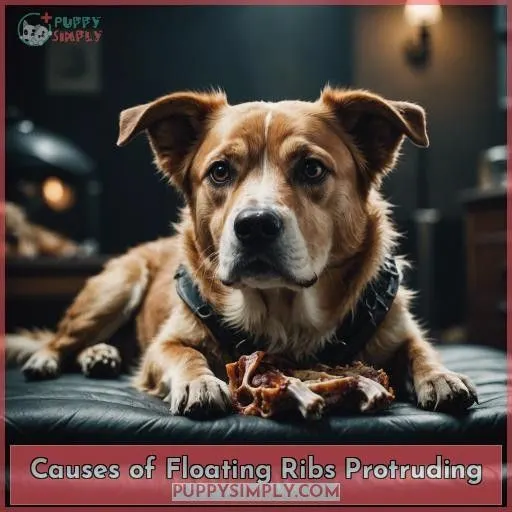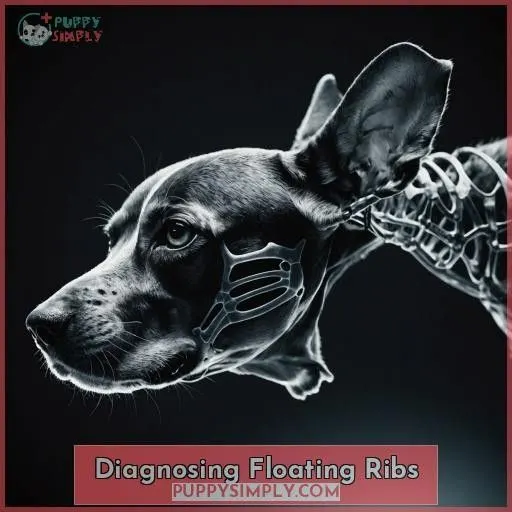This site is supported by our readers. We may earn a commission, at no cost to you, if you purchase through links.

Protruding floating ribs can signal underlying issues like eating non-food items, breed characteristics, or health conditions like masticatory myositis.
Your vet can diagnose floating rib issues through physical exams and imaging tests, ruling out broken ribs. Treatment involves addressing root causes, dietary changes, and monitoring for complications.
Stay vigilant for sudden changes in appearance, pain, or altered behavior – indicators it’s time to enlist professional veterinary expertise to explore this peculiar condition further.
Table Of Contents
Key Takeaways
- Floating ribs are a normal anatomical feature in dogs that provide flexibility and shock absorption, but protruding ribs can signal underlying issues like eating non-food items, breed characteristics, or health conditions like masticatory myositis.
- Veterinarians diagnose floating rib issues through physical exams and imaging tests, ruling out broken ribs, and treatment involves addressing root causes, dietary changes, and monitoring for complications.
- Sudden changes in appearance, pain, or altered behavior are indicators it’s time to enlist professional veterinary expertise to explore this peculiar condition further.
- Proper weight management, dietary changes, and regular veterinary checkups are essential for managing floating ribs in dogs and preventing potential complications.
What Are Floating Ribs in Dogs?
You’re no doubt familiar with the term ribs, referring to the curved bones that form the rib cage and protect critical organs. Floating ribs, specifically, are the last pair of ribs that attach to the spine but not the sternum (breastbone), often with a bony protrusion capped by cartilage that can protrude under the skin.
Definition of Floating Ribs
Floating ribs are the last pair of ribs in dogs that don’t connect to the sternum. They’re called floating because they’re only attached to the spine. Sometimes, these ribs can protrude or stick out, which may look concerning to pet owners. However, floating ribs are a normal anatomical feature and not a cause for alarm unless accompanied by other symptoms.
Location of Floating Ribs in Dogs
Floating ribs are the last pair of ribs in a dog’s ribcage, located at the rear. Unlike other ribs, floating ribs:
- Attach to the spine but not the sternum
- Have cartilage that ends freely in the muscles
- Provide flexibility and shock absorption for the spine
- Evolved to accommodate a dog’s range of motion
- Are less prominent in humans due to our upright posture
Causes of Floating Ribs Protruding
You may notice your dog’s floating ribs protruding more on one side due to underlying health issues or dietary habits. Causes can range from eating non-food items that create blockages to breed characteristics that make floating ribs more prominent.
Eating Non-food Items
Eating non-food items, like toys or socks, can cause floating ribs to protrude.
This behavior, known as pica, may stem from dietary deficiencies or boredom.
Ingesting inorganic things can lead to digestive issues and gastrointestinal blockages.
Proper dietary management and enrichment activities can help curb this habit.
However, if your dog continues eating non-food items, consult your veterinarian to rule out underlying health conditions and prevent potential complications.
Underlying Health Conditions
Floating ribs can protrude from several underlying conditions:
- Masticatory myositis – inflammation causing muscle wasting around the occiput.
- Trapped nerve endings causing pain near the ribs.
- Canine massage therapy focuses on the occiput for overall health and well-being.
Vigilance is key – changes in a dog’s rib appearance or discomfort may signal an issue requiring veterinary attention.
Breed Characteristics
Certain dog breeds are more prone to protruding floating ribs due to their unique conformation. For example, sighthounds like Greyhounds and Whippets have a lean build that can accentuate the appearance of floating ribs. Proper weight management is key to maintaining a healthy appearance. Consult your vet about breed-specific health screening and care to make sure your pup’s well-being.
| Breed | Floating Rib Appearance | Considerations |
|---|---|---|
| Greyhound | Prominent | Lean build, weight management |
| Whippet | Visible | Conformation, health screening |
| Pug | Less Noticeable | Brachycephalic, respiratory health |
| Bulldog | Minimal | Stocky build, weight monitoring |
Diagnosing Floating Ribs
To diagnose floating ribs, your veterinarian will perform a thorough physical examination, feeling along your dog’s ribcage for any abnormalities. If floating ribs are suspected, imaging tests like X-rays or CT scans may be recommended to get a clearer view and rule out other potential causes.
Physical Examination by Veterinarian
During a physical exam, your vet will carefully palpate your dog’s floating ribs. They may use anesthesia if needed for a thorough assessment. Palpation helps rule out broken ribs or other issues.
Your vet will also examine your dog’s third eyelid, sagittal crest, and any bumps or knots.
This knowledge helps determine the prognosis and next steps in your dog’s care.
Imaging Tests (X-rays, CT Scans)
If your vet suspects floating ribs, they may recommend imaging tests like X-rays or CT scans. While X-rays provide a quick overview, CT scans offer more detailed information about the ribs and surrounding structures. These advanced techniques help rule out other conditions and guarantee an accurate diagnosis, allowing your vet to develop the best treatment plan for your furry friend.
| Imaging Technique | Benefits | Limitations |
|---|---|---|
| X-rays | Quick, affordable | Limited detail |
| CT scans | High resolution, 3D images | Expensive, requires anesthesia |
| Ultrasound | Non-invasive, no radiation | Operator-dependent, limited bone visualization |
Ruling Out Other Conditions
To rule out other conditions, your vet will perform a thorough physical exam.
They will look for signs of pain, swelling, or abnormalities.
They may recommend imaging tests like X-rays or CT scans.
These tests can check for broken ribs, tumors, or foreign objects.
Blood work can help identify underlying issues.
These issues may include respiratory problems or digestive issues.
With a proper diagnosis, your vet can provide the best treatment for your pup’s floating ribs.
Treating Floating Ribs
You’ll need to address any underlying causes contributing to your dog’s protruding floating ribs, such as a dietary issue or a health condition. Dietary changes, medication (if prescribed by your veterinarian), and close monitoring for potential complications are essential steps in managing this peculiar condition.
Addressing Underlying Causes
If your dog’s floating ribs are protruding due to an underlying condition, your vet will recommend appropriate treatment.
They may suggest dietary changes, medications, or monitoring, depending on the cause.
Breed considerations and your dog’s overall health will guide the treatment plan.
Always consult your vet and follow their advice to safeguard your pup’s well-being.
Seek emergency care if your dog shows signs of distress.
Dietary Changes
Dietary changes can help manage floating ribs in dogs. Maintain a healthy weight through portion control and regular exercise. Avoid table scraps and choose a high-quality, age-appropriate diet. If your dog has food allergies, work with your vet to identify and eliminate trigger ingredients. Proper nutrition supports overall health and may reduce digestive issues related to floating ribs.
Medication (if Needed)
If your dog’s floating ribs are causing discomfort, your vet may prescribe medication. Options include:
- Anti-inflammatory drugs to reduce swelling and pain
- Pain relievers to manage discomfort
- Antibiotics if an infection is present
Discuss potential side effects and the long-term prognosis with your vet. Prevent complications by following your vet’s treatment plan. Seek emergency care if your dog shows signs of severe pain or distress.
Monitoring for Complications
After addressing the underlying cause of your dog’s protruding floating rib, it’s essential to keep an eye out for potential complications.
Regular veterinary checkups will help make sure the rib heals correctly and there are no infections.
Changes to your dog’s diet may be needed to prevent future problems.
Stay alert for any signs of pain or discomfort.
Talk to your vet if the rib keeps sticking out or causing problems.
When to See a Veterinarian
While some floating rib protrusion in dogs can be normal and harmless, it’s important to consult your veterinarian if you notice sudden changes in the appearance of your dog’s floating ribs.
If your dog shows signs of pain or discomfort, has changes in appetite or behavior, or if you have concerns about your dog’s overall health, prompt veterinary attention can help identify and address any underlying issues before they worsen.
Sudden Changes in Appearance of Floating Ribs
If your dog’s floating ribs suddenly protrude more than usual, it could indicate abnormal protrusions, impacted objects, or changes in weight.
Consult your vet if the appearance is drastically different from your dog’s normal, especially if accompanied by lethargy, loss of appetite, or vomiting.
Breed variation and massage therapy may help, but sudden changes warrant a professional opinion to rule out serious issues.
Signs of Pain or Discomfort
If your dog’s floating rib protrusion causes pain, it’s time to see the vet.
Breeds with prominent ribs may need pain management.
Sudden rib changes or signs of discomfort like limping, aggression, or excessive licking require medical intervention.
Don’t wait – consult your veterinarian to determine the cause and develop an appropriate treatment plan for your pup’s unique needs and breed.
Changes in Appetite or Behavior
If your dog’s floating ribs are accompanied by appetite loss, lethargy, vomiting, constipation, or unexplained weight loss, it’s time to see your vet. These symptoms could indicate an underlying health issue that requires prompt attention. Don’t wait – make an appointment right away to get your pup back to their happy, healthy self.
Concerns About Overall Health
If you observe unexpected alterations in the appearance of your dog’s floating ribs, coupled with indications of discomfort, variations in appetite or conduct, or have general apprehensions about their health, it’s imperative to seek veterinary attention without delay. They can assess your pup, determine any underlying reasons, and propose suitable dietary modifications or remedies to safeguard their well-being.
- Unexpected alterations in floating rib appearance
- Indications of pain or discomfort
- Variations in appetite or conduct
- General apprehensions about your dog’s health
Frequently Asked Questions (FAQs)
Can floating ribs cause pain in dogs?
Imagine you’re peeking at your pup’s ribs – those floating ones can be tender if triggered. While not usually painful, tugging or pressure could make your furry friend wince uncomfortably.
Are floating ribs more common in certain dog breeds?
Yes, some breeds with deeper chests like Greyhounds and Whippets tend to have more pronounced floating ribs visible under the skin.
Can floating ribs be surgically removed if protruding?
An ounce of prevention is worth a pound of cure. You can surgically remove protruding floating ribs, but it’s rarely necessary. Speak to your vet about managing any discomfort or potential issues instead.
Do floating ribs affect a dogs ability to run?
Floating ribs shouldn’t affect your dog’s ability to run. As long as they’re not causing discomfort, these ribs are just part of your pup’s unique anatomy.
Can floating ribs be felt in overweight or obese dogs?
You can indeed feel a dog’s floating ribs if they’re overweight or obese. The extra fat makes these rear ribs more noticeable when you run your hands along their sides.
Conclusion
Keeping a watchful eye on your dog’s floating ribs is akin to monitoring a delicate scale – any sudden imbalance could signal an underlying issue.
By familiarizing yourself with this peculiar condition, you’ll be equipped to recognize concerning changes and promptly consult your vet.
With proper diagnosis and treatment addressing root causes, your canine companion can maintain a comfortable, healthy life without the burden of protruding floating ribs.











